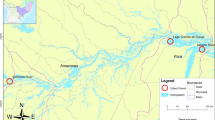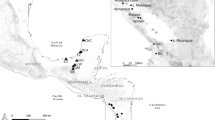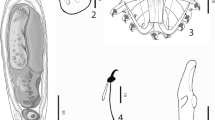Abstract
We describe three new Henneguya spp. (Myxobolidae) found parasitizing two species of cichlid fish from the Amazon basin, Brazil: H. tucunarei n. sp. from gill filaments of Cichla monoculus and H. tapajoensis n. sp. from gill filaments of Cichla pinima, both from the Tapajós River, Pará State and H. jariensis n. sp. in the fins of Cichla monoculus from the Jari River, Amapá State. We based descriptions on myxospore morphology and small subunit ribosomal DNA sequences, and used a phylogenetic analysis to compare the new Henneguya species with known relatives. Spores of the three species had similar morphology and morphometrics, but differed molecularly 5–7.5%, and were no more than 94% similar to any other sequence in GenBank. Together with having different hosts, these data supported the diagnosis of the parasites as distinct, novel species. Maximum likelihood and Bayesian analyses showed that H. tucunarei n. sp., H. tapajoensis n. sp., and H. jariensis n. sp. plus Henneguya paraensis (which parasitizes Cichla temensis) formed a well-supported sub-clade of Henneguya parasites of cichlids from the Amazon basin, in a lineage sister to those in characiforms hosts. Our analysis was consistent with previous studies that suggest that aquatic environment and vertebrate host group are the strongest correlates with phylogenetic signals in the Myxobolidae.




Similar content being viewed by others
References
Abdel-Gaber R, Abdel-Ghaffar F, Maher S, El-Mallah AM, Al Quraishy S, Mehlhorn H (2017) Morphological re-description and phylogenetic relationship of five myxosporean species of the family Myxobolidae infecting Nile tilapia. Dis Aquat Org 124(3):201–214. https://doi.org/10.3354/dao03118
Altschul SF, Madden TL, Schaffer AA, Zhang J, Zhang Z, Miller W, Lipman DJ (1997) Gapped BLASTn and PSI-BLAST: a new generation of protein database search programs. Nucleic Acids Res 25(17):3389–3302. https://doi.org/10.1093/nar/25.17.3389
Azevedo C, Matos E (1995) Henneguya adherens n. Sp. (Myxozoa, Myxosporea), parasite of the Amazonian fish, Acestrorhynchus falcatus. J Eukaryot Microbiol 42(5):515–518
Azevedo C, Matos E (1996) Henneguya malabarica sp. nov. (Myxozoa, Myxobolidae) in the Amazonian fish Hoplias malabaricus. Parasitol Res 82(3):222–224
Azevedo C, Matos E (2002) Fine structure of the myxosporean, Henneguya curimata n. Sp., parasite of the Amazonian fish, Curimata inormata (Teleostei, Curimatidae). J Eukaryot Microbiol 49(3):197–200
Azevedo C, Corral L, Matos E (1997) Light and ultrastructural data on Henneguya testicularis n. Sp. (Myxozoa, Myxobolidae), a parasite from the testis of the Amazonian fish Moenkhausia oligolepis. Syst Parasitol 37(2):111–114
Azevedo C, Casal G, Matos P, Matos E (2008) A new species of Myxozoa, Henneguya rondoni n. Sp. (Myxozoa), from the peripheral nervous system of the Amazonian fish, Gymnorhamphichthys rondoni (Teleostei). J Eukaryot Microbiol 55(3):229–234. https://doi.org/10.1111/j.1550-7408.2008.00317.x
Azevedo C, Casal G, Matos P, Alves A, Matos E (2011) Henneguya torpedo sp. nov. (Myxozoa), a parasite from the nervous system of the Amazonian teleost Brachyhypopomus pinnicaudatus (Hypopomidae). Dis Aquat Org 93(3):235–342. https://doi.org/10.3354/dao02292
Barta JR, Martin DS, Liberator PA, Dashkevicz M, Anderson JW, Feighner SD, Elbrecht A, Perkins-Barrow A, Jenkins MC, Danforth HD, Ruff MD, Profous-Juchelka H (1997) Phylogenetic relationships among eight Eimeria species infecting domestic fowl inferred using complete small subunit ribosomal DNA sequences. J Parasitol 83(2):262–271. https://doi.org/10.2307/3284453
Batista VS, Petrere M (2003) Characterization of the commercial fish production landed at Manaus, Amazonas State, Brazil. Acta Amaz 33(1):53–66. https://doi.org/10.1590/1809-4392200331066
Ben-David J, Atkinson SD, Pollak Y, Yossifon G, Shavit U, Bartholomew JL, Lotan T (2016) Myxozoan polar tubules display structural and functional variation. Parasit Vectors 9(1):549. https://doi.org/10.1186/s13071-016-1819-4
Carriero MM, Adriano EA, Silva MRM, Ceccarelli PS, Maia AAM (2013) Molecular phylogeny of the Myxobolus and Henneguya genera with several new South American species. PLoS One 8(9):e73713. https://doi.org/10.1371/journal.pone.0073713
Casal G, Matos E, Azevedo C (2003) Light and electron microscopic study of the myxosporean, Henneguya friderici n. Sp. from the Amazonian teleostean fish, Leporinus friderici. Parasitology 126:313–319
Dos Santos CHS, De Sousa CFS, Paula-Silva MN, Val AL, Almeida-Val VMF (2012) Genetic diversity in Cichla monoculus (Spix & Agassiz, 1931) populations: implications for management and conservation. Am J Environ Sci 8:35–41
Diamant A, Whipps CM, Kent ML (2004) A new species of Sphaeromyxa (Myxosporea: Sphaeromyxina: Sphaeromyxidae) in devil firefish, Pterois miles (Scorpaenidae), from the northern Red Sea: morphology, ultrastructure, and phylogeny. J Parasitol 90(6):1434–1442. https://doi.org/10.1645/GE-336R
Eiras J (2002) Synopsis of the species of the genus Henneguya Thélohan, 1892 (Myxozoa: Myxosporea: Myxobolidae). Syst Parasitol 52(1):43–54. https://doi.org/10.1023/A:1015016312195
Eiras J, Adriano EA (2012) A checklist of new species of Henneguya Thélohan, 1892 (Myxozoa: Myxosporea, Myxobolidae) described between 2002 and 2012. Syst Parasitol 83(2):95–104. https://doi.org/10.1007/s11230-012-9374-7
Eiras JC, Malta JC, Varela A, Pavanelli GC (2004) Henneguya schizodon n. Sp. (Myxozoa, Myxobolidae), a parasite of the Amazonian teleost fish Schizodon fasciatus (Characiformes, Anostomidae). Parasite 11(2):169–173
Feijó MM, Arana S, Ceccarelli PS, Adriano EA (2008) Light and scanning electron microscopy of Henneguya arapaima n. Sp. (Myxozoa: Myxobolidae) and histology of infected sites in pirarucu (Arapaima gigas: Pisces: Arapaimidae) from the Araguaia River, Brazil. Vet Parasitol 157(1–2):59–64. https://doi.org/10.1016/j.vetpar.2008.06.009
Feist SW (2008) Myxozoan diseases. In: Eiras JC, Segner H, Wahli T, Kapoor BG (eds) fish diseases. Science publishers, Enfield, pp 613–682
Feist SW, Longshaw M (2006) Phylum Myxozoa. In: Woo PTK (ed) Fish diseases and disorders: protozoan and metazoan infections, 2nd edn. CAB International, Oxfordshire, pp 230–296. https://doi.org/10.1079/9780851990156.0230
Ferguson JA, Atkinson SD, Whipps CM, Kent ML (2008) Molecular and morphological analysis of Myxobolus spp. pf salmonids fishes with the description of a new Myxobolus species. J Parasitol 94:322–1334. https://doi.org/10.1645/GE-1606.1
Fiala I (2006) The phylogeny of Myxosporea (Myxozoa) based on small subunit ribosomal RNA gene analysis. Int J Parasitol 36(14):1521–1534. https://doi.org/10.1016/j.ijpara.2006.06.016
Fiala I, Bartošova-Sojková P, Okamura B, Hartikainen H (2015) Adaptive radiation and evolution within the Myxozoa. In: Okamura B, Gruhl A, Bartholomew JL (eds) Myxozoan evolution. Ecology and development. Springer, Cham, pp 69–84. https://doi.org/10.1007/978-3-319-14753-6_4
Freitas CEC, Campos CP (2014) Yield per recruit of the peacock bass Cichla monoculus (Spix and Agassiz, 1831) caught in Lago Grande at Manacapuru (Amazonas - Brazil). Braz J Biol 4:226–230
Froese R, Pauly D (2017) FishBase. World Wide Web electronic publication. http://www.fishbase.org. Accessed November 2017
Guindon S, Gascuel O (2003) A simple, fast and accurate algorithm to estimate large phylogenies by maximum likelihood. Syst Biol 52(5):696–604. https://doi.org/10.1080/10635150390235520
Guindon S, Dufayard JF, Lefort V, Anisimova M, Hordijk W, Gascuel O (2010) New algorithms and methods to estimate maximum-likelihood phylogenies: assessing the performance of PhyML 3.0. Syst Biol 59(3):307–321. https://doi.org/10.1093/sysbio/syq010
Hall TA (2011) BioEdit: a user-friendly biological sequence alignment editor and analysis program for Windows 95/98/NT. Nucl Acids Symp Ser 41:95–98
Hallett SL, Diamant A (2001) Ultrastructure and small-subunit ribosomal DNA sequence of Henneguya lesteri n. sp. (Myxosporea), a parasite of sand whiting Sillagoanalis (Sillaginidae) from the coast of Queensland, Australia. Dis Aquat Org 46(3):197–212. https://doi.org/10.3354/dao046197
Hoeinghaus DJ, Layman CA, Arrington AD, Winemiller KO (2003) Movement of Cichla species (Cichlidae) in a Venezuelan floodplain river. Neotrop Ichthyol 1(2):121–126. https://doi.org/10.1590/S1679-62252003000200006
Kumar S, Stecher G, Tamura K (2016) MEGA7: molecular evolutionary genetics analysis version 7.0. Mol Biol Evol 33(7):1870–1874. https://doi.org/10.1093/molbev/msw054
Kullander SO, Ferreira EJG (2006) A review of the South American cichlid genus Cichla, with descriptions of nine new species (Teleostei: Cichlidae). Ichthyol Explor Fresh 17:289–398
Kent ML, Andree KB, Bartholomew JL, El-Matbouli M, Desser SS, Devlin RH, Feist SW, Hedrick RP, Hoffmann RW, Khattra J, Hallett SL, Lester RJ, Longshaw M, Palenzeula O, Siddall ME, Xiao C (2001) Recent advances in our knowledge of the Myxozoa. J Eukaryot Microbiol 48(4):395–413. https://doi.org/10.1111/j.1550-7408.2001.tb00173.x
Lom J, Arthur JR (1989) A guideline for the preparation of species descriptions in Myxosporea. J Fish Dis 12(2):151–156. https://doi.org/10.1111/j.1365-2761.1989.tb00287.x
Lom J, Dyková I (2006) Myxozoan genera: definition and notes on taxonomy, life-cycle terminology and pathogenic species. Folia Parasitol 53(1):1–36
Matos E, Tajdari J, Azevedo C (2005) Ultrastructural studies of Henneguya rhamdia n. Sp. (Myxozoa) a parasite from the Amazon teleost fish, Rhamdia quelen (Pimelodidae). J Eukaryot Microbiol 52(6):532–537
Mathews PD, Maia AA, Adriano EA (2016) Henneguya melini n. sp. (Myxosporea: Myxobolidae), a parasite of Corydoras melini (Teleostei: Siluriformes) in the Amazon region: morphological and ultrastructural aspects. Parasitol Res 115(9):3599–3604. https://doi.org/10.1007/s00436-016-5125-z
Molnár K (1998) Taxonomic problems, seasonality and histopathology of Henneguya creplini (Myxosporea) infection of the pikeperch Stizostedion lucioperca in Lake Balaton. Folia Parasitol 45(4):261–269
Molnár K, Ranzani-Paiva MJ, Eiras JC, Rodrigues EL (1998) Myxobolus macroplasmodialis sp. n. (Myxozoa: Myxosporea), a parasite of the abdominal cavity of the characid teleost, Salminus maxillosus, in Brazil. Acta Protozool 37:241–245
Molnár K, Marton S, Eszterbauer E, Székely C (2006) Comparative morphological and molecular studies on Myxobolus spp. infecting chub from the River Danube, Hungary, and description of M. muellericus sp. n. Dis Aquat Org 73(1):49–61. https://doi.org/10.3354/dao073049
Moreira GSA, Adriano EA, Silva MRM, Ceccarelli OS, Maia AAM (2014a) Morphology and 18S rDNA sequencing identifies Henneguya visibilis n. sp., a parasite of Leporinus obtusidens from Mogi Guaçu River, Brazil. Parasitol Res 113(1):81–90. https://doi.org/10.1007/s00436-013-3629-3
Moreira GSA, Adriano EA, Silva MRM, Ceccarelli PS, Maia AAM (2014b) The morphological and molecular characterization of Henneguya rotunda n. sp., a parasite of the gill arch and fins of Salminus brasiliensis from the Mogi Guaçu River, Brazil. Parasitol Res 113(5):1703–1711. https://doi.org/10.1007/s00436-014-3815-y
Naldoni J, Maia AAM, Silva MRM, Adriano EA (2014) Henneguya cuniculator sp. nov., a parasite of spotted sorubim Pseudoplatystoma corruscans in the São Francisco Basin, Brazil. Dis Aquat Org 107(3):211–221. https://doi.org/10.3354/dao02685
Posada D (2008) jModelTest: phylogenetic model averaging. Mol Biol Evol 25:1253–1256. https://doi.org/10.1093/molbev/msn083
Rambaut A (2008) FigTree v1.1.1: tree figure drawing tool, available from http://tree.bio.ed.ac.uk/software/figtree/
Rambaut A, Drummond AJ (2007) Trace v1.4, available from http://beast.bio.ed.ac.uk/Tracer
Reis RE, Albert JS, Dario FD, Mincarone MM, Petry P, Rocha LA (2016) Fish biodiversity and conservation in South America. J Fish Biol 89(1):12–47. https://doi.org/10.1111/jfb.13016
Rocha E, Matos E, Azevedo C (1992) Henneguya amazonica n.Sp. (Myxozoa, Myxobolidae), parasitizing the gills of Crenicichla lepidota Heckel, 1840 (Teleostei, Cichlidae) from Amazon river. Eur J Protistol 28(3):273–278
Rocha S, Casal G, Garcia P, Matos E, Al-Quraishy S, Azevedo C (2014) Ultrastructure and phylogeny of the parasite Henneguya carolina sp. nov. (Myxozoa), from the marine fish Trachinotus carolinus in Brazil. Dis Aquat Org 112(2):139–148. https://doi.org/10.3354/dao02794
Ronquist F, Huelsenbeck JP (2003) MrBayes 3: Bayesian phylogenetic inference under mixed models. Bioinformatics 19(12):11572–11574. https://doi.org/10.1093/bioinformatics/btg180
Thompson JD, Higgins DG, Gilson TJ (1994) Clustal W: improving the sensitivity of progressive multiple sequence alignment through sequence weighting, position-specific gap penalties and weight matrix choice. Nucl Acid Res 22(22):4673–4680. https://doi.org/10.1093/nar/22.22.4673
Videira M, Velasco M, Azevedo R, Silva R, Gonçalves Matos P, Matos E (2015) Morphological aspects of Henneguya aequidens n. sp. (Myxozoa: Myxobolidae) in Aequidens plagiozonatus Kullander, 1984 (Teleostei: Cichlidae) in the Amazon region, Brazil. Parasitol Res 114(3):1159–1162. https://doi.org/10.1007/s00436-014-4295-9
Velasco M, Videira M, Nascimento LCS, Matos P, Gonçalves EC, Matos E (2016) Henneguya paraensis n. sp. (Myxozoa; Myxosporea), a new gill parasite of the Amazonian fish Cichla temensis (Teleostei: Cichlidae): morphological and molecular aspects. Parasitol Res 115(5):177–91787. https://doi.org/10.1007/s00436-016-4916-6
Vital P, Corral L, Matos E, Azevedo C (2003) Ultrastructural aspects of the myxosporean Henneguya astyanax n. Sp. (Myxozoa: Myxobolidae), a parasite of the Amazonian teleost Astyanax keithi (Characidae). Dis Aquat Org 53(1):55–60
Willis SC, Nunes MS, Montana CG, Farias IP, Lovejoy NR (2007) Systematics, biogeography, and evolution of the Neotropical peacock bases Cichla (Perciformes: Cichlidae). Mol Phy Evol 44:291–307
Zatti SA, Atkinson SD, Bartholomew JL, Maia AAM, Adriano EA (2017) Amazonian waters harbour an ancient freshwater Ceratomyxa lineage (Cnidaria: Myxosporea). Acta Trop 169:100–106. https://doi.org/10.1016/j.actatropica.2017.02.006
Zhang ZQ (2011) Animal biodiversity: an introduction to higher-level classification and taxonomic richness. Zootaxa 3148:7–12
Acknowledgments
The authors thank Prof. Dr. Lincoln Corrêa (UFOPA), Prof. Dr. Marcos Tavares-Dias, and Marcos Oliveira for assistance with fieldwork; the fishermen of the communities of Jari do Socorro; Santarém, Pará State; and of Jarilândia, Amapá State, for their local knowledge of fish availability and provision of material for study; and Prof. Dr. Regina Maura Bueno Franco (UNICAMP) for providing some of the equipment used in this study.
Funding
Part of this research was conducted while SAZ was a visiting scholar at Oregon State University, USA, which was sponsored by the CAPES Foundation within the Ministry of Education, Brazil (grant n. BEX–6729/2015-00). SAZ was also supported by a Ph.D. scholarship provided by CAPES to UNICAMP. This study was supported by the São Paulo Research Foundation–FAPESP (Procs. n. 2016/22047 to EAA). EAA received a research productivity grant from the Brazilian Fostering Agency CNPq (Proc. n. 301886/2016-4).
Author information
Authors and Affiliations
Corresponding author
Electronic supplementary material
Fig. S1
Consensus ML phylogenetic tree using ssrDNA sequences of selected Myxobolus/Henneguya species, under GTR+G model. GenBank accession numbers are given in parenthesis. Nodal supports are indicated for ML with a bootstrap of 1000 replicates. Values for weakly supported nodes (< 50) are not shown. Asterisk corresponds to the African cichlids (Abdel-Gaber et al. 2017). Scale is 0.20. (GIF 1179 kb)
Rights and permissions
About this article
Cite this article
Zatti, S.A., Atkinson, S.D., Maia, A.A.M. et al. Novel Henneguya spp. (Cnidaria: Myxozoa) from cichlid fish in the Amazon basin cluster by geographic origin. Parasitol Res 117, 849–859 (2018). https://doi.org/10.1007/s00436-018-5762-5
Received:
Accepted:
Published:
Issue Date:
DOI: https://doi.org/10.1007/s00436-018-5762-5




